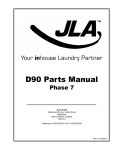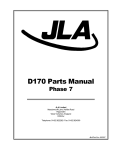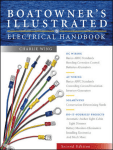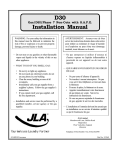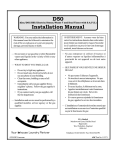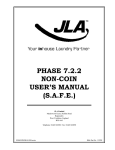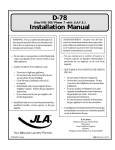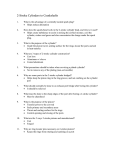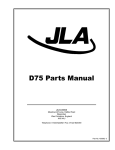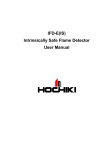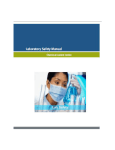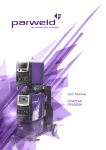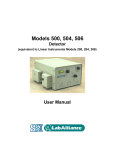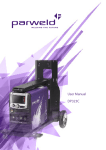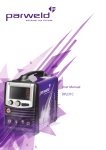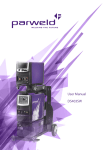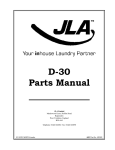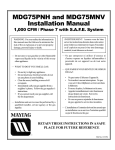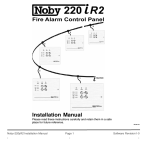Download D20 (II) Installation Manual
Transcript
D20 (II) Installation Manual WARNING: For your safety the information in this manual must be followed to minimize the risk of fire or explosion or to prevent property damage, personal injury or death. — Do not store or use gasoline or other flammable vapors and liquids in the vicinity of this or any other appliance. — WHAT TO DO IF YOU SMELL GAS: • • • • Do not try to light any appliance. Do not touch any electrical switch; do not use any phone in your building. Clear the room, building or area of all occupants. Immediately call your gas supplier from a neighbor’s phone. Follow the gas supplier’s instructions. • If you cannot reach your gas supplier, call the fire department. — Installation and service must be performed by a qualified installer, service agency or the gas supplier. JLA Limited Meadowcroft Lane, Halifax Road – Ripponden West Yorkshire, England HX6 4AJ Telephone: 01422 822282 / Fax: 01422 824390 JLA Part No. 113197 Retain This Manual in a Safe Place for Future Reference This product embodies advanced concepts in engineering, design, and safety. If this product is properly maintained, it will provide many years of safe, efficient, and trouble free operation. Only qualified technicians should service this equipment. OBSERVE ALL SAFETY PRECAUTIONS displayed on the equipment or specified in the installation manual included with the dryer. The following “FOR YOUR SAFETY” caution must be posted near the dryer in a prominent location. FOR YOUR SAFETY Do not store or use gasoline or other flammable vapors and liquids in the vicinity of this or any other appliance. We have tried to make this manual as complete as possible and hope you will find it useful. The manufacturer reserves the right to make changes from time to time, without notice or obligation, in prices, specifications, colors, and material, and to change or discontinue models. The illustrations included in this manual may not depict your particular dryer exactly. IMPORTANT For your convenience, log the following information: D20 DATE OF PURCHASE ____________________________________________________ MODEL NO. _____________________ DISTRIBUTOR’S NAME ____________________________________________________________________________________ Serial Number(s) ________________________________________________________________________________________ ______________________________________________________________________________________________________ ______________________________________________________________________________________________________ Replacement parts can be obtained from your distributor or JLA. When ordering replacement parts, you can FAX your order to JLA at 01422 824390 or telephone your order directly to the JLA Parts Department at 01422 822282. Please specify the dryer model number and serial number in addition to the description and part number, so that your order is processed accurately and promptly. “IMPORTANT NOTE TO PURCHASER” Information must be obtained from your local gas supplier on the instructions to be followed if the user smells gas. These instructions must be posted in a prominent location near the dryer. IMPORTANT You must disconnect and lockout the electric supply and the gas supply or the steam supply before any covers or panels are removed from the machine to allow access for cleaning, adjusting, installation, or testing of any equipment per OSHA standards. Table of Contents Safety Precautions .............................. 4 Specifications ...................................... 5 Installation Procedures ....................... 7 When discarding or storing your old clothes dryer, remove the door. Unpacking/Setting Up .................................................... 7 Location Requirements .................................................. 7 Dryer Enclosure Requirements ..................................... 7 Fresh Air Supply Requirements ..................................... 8 Exhaust Requirements .................................................. 8 Electrical Information ................................................... 10 Gas Information ........................................................... 12 Preparation for Operation/Start-Up ............................... 14 Preoperational Test ...................................................... 14 Preoperational Instructions .......................................... 14 Shutdown Instructions ................................................. 15 CAUTION Dryer(s) should never be left unattended while in operation. Service ......................................................................... 15 Parts ............................................................................ 15 Please observe all safety precautions displayed on the equipment and/or specified in the installation manual included with the dryer. Dryer must be installed in a location/environment, which the ambient temperature remains between 40° F (4.44° C) and 130° F (54.44° C). “Caution: Label all wires prior to disconnection when servicing controls. Wiring errors can cause improper operation.” WARNING Do not allow children to play on or in the appliance. Close supervision of children is necessary when the appliance is used near children. Under no circumstances should the dryer main door switch, lint drawer/tray switch, or the heat circuit devices ever be disabled. Service/Parts Information ................. 15 Warranty Information ........................ 15 Returning Warranty Cards ........................................... 15 Warranty ...................................................................... 15 Routine Maintenance ......................... 15 Procedure for Functional Check of Replacement Components ............ 16 Data Label Information...................... 18 S.A.F.E. System .................................. 18 The dryer must never be operated with any of the back guards, outer tops, or service panels removed. Personal injury or fire could result. The dryer must never be operated without the lint filter/screen in place, even if an external lint collection system is used. FOR YOUR SAFETY Do not dry mop heads in the dryer. Do not use dryer in the presence of dry cleaning fumes. The dryers must not be installed or stored in an area where it will be exposed to water and/or weather. The wiring diagram for the dryer is located behind the front control panel. ABBREVIATION _______________________________ D.M.S. DSI HVAC in WC L.C.D. L.E.D. OSHA S.A.F.E. UL Drill Measurement Size Direct Spark Ignition Heating, Ventilating, and Air-Conditioning Inches of Water Column Liquid Crystal Display Light Emitting Diode Occupational Safety and Health Administration Sensor Activated Fire Extinguishing System Underwriters Laboratories Safety Precautions __________________ Warning ! For your safety, the information in this manual must be followed to minimize the risk of fire or explosion or to prevent property damage, personal injury, or loss of life. For personal safety, the dryer must be electrically grounded in accordance with country, state, and local codes. For the U.K., the following electrical and other local regulations must be referred to: • BS 7671:1992 (16th edition) IEE Wiring Regulations, • National and Local Building Regulations • Fire Authority Requirements The dryer must never be operated with the back guard removed. Personal injury or fire could result. • Any relevant requirements of the Local Authority and the Health & Safety Executive Do not store or use gasoline or other flammable vapors and liquids in the vicinity of this or any other appliance. Note ! Purchaser/user should consult the local gas supplier for proper instructions to be followed in the event the user smells gas. The instructions should be posted in a prominent location. Failure to electrically ground the dryer properly will void the warranty. Warning ! Personal injury or fire could result should the dryer main door switch, lint drawer/tray switch, or the heat circuit devices ever be disabled. What To Do If You Smell Gas: • Do not try to light any appliance. • Do not touch any electrical switch. This dryer is not to be used in the presence of dry cleaning solvents or fumes. • Do not use any phone in your building. Remove articles from the dryer as soon as the drying cycle has been completed. • Clear the room, building, or area of all occupants. • Immediately call your gas supplier from a neighbor’s phone. Follow the gas supplier’s instructions. Warning ! • If you cannot reach your gas supplier, call the fire department. Installation and service must be performed by a qualified installer, service agency, or gas supplier. Articles left in the dryer after the drying and cooling cycles have been completed can create a fire hazard. Read and follow all caution and direction labels attached to the dryer. This dryer must be exhausted to the outdoors. Although JLA produces a very versatile dryer, there are some articles that, due to fabric composition or cleaning method, should not be dried in it. Warning ! Dry only water washed fabrics. Do not dry articles spotted or washed in dry cleaning solvents, a combustible detergent, or “all purpose” cleaner. Explosion could result. Do not dry rags or articles coated or contaminated with gasoline, kerosene, oil, paint, or wax. Explosion could result. Warning ! You must disconnect and lockout the electric supply and the gas supply or the steam supply before any covers or panels are removed from the machine to allow access for cleaning, adjusting, installation, or testing of any equipment per OSHA standards. Important ! Dryer must be installed in a location/environment, which the ambient temperature remains between 40º F (4.44º C) and 130º F (54.44º C). Do not dry mop heads. Contamination by wax or flammable solvents will create a fire hazard. Do not use heat for drying articles that contain plastic, foam, sponge rubber, or similarly textured rubber materials. Drying in a heated tumbler may damage plastics or rubber and may be a fire hazard. A program should be established for the inspection and cleaning of lint in the exhaust ductwork and area around the back of the dryer. The frequency of inspection and cleaning can best be determined from experience at each location. Warning ! 4 The collection of lint in the exhaust ductwork can create a potential fire hazard. JLA Limited 113197-5 Specifications _____________________________________________________________________ MAXIMUM CAPACITY (DRY WEIGHT) 20 lbs 9 kg BASKET (TUMBLER) DIAMETER 25-3/4” 65.4 cm 24” 60.95 cm BASKET (TUMBLER) VOLUME 7.5 cu ft 0.21 cu m BASKET (TUMBLER) MOTOR 1/4 hp 0.19 kW BLOWER MOTOR 1/8 hp 0.09 kW CABINET WIDTH 27” 68.6 cm CABINET DEPTH 30-5/8” 77.78 cm CABINET HEIGHT 41-1/4” 104.78 cm 4” 10.2 cm 40,000 Btu/hr 11.71 kW AIRFLOW @ 60 Hz 230 cfm 6.51 cmm AIRFLOW @ 50 Hz 210 cfm 5.85 cmm BASKET (TUMBLER) DEPTH EXHAUST CONNECTION HEAT INPUT Electric Gas WATER CONNECTION 3/4” M.N.P.T. VOLTAGE AVAILABLE 120v, 208v, 240v / 60 Hz / 1ø 240v / 50 Hz / 1ø NET WEIGHT 246-1/2 lbs INLET PIPE CONNECTION 111.8 kg 3/8” M.N.P.T. VOLTAGE AVAILABLE 208v, 240v / 60 Hz / 1ø 240v / 50 Hz / 1ø 380v, 400v, 416v / 50 Hz / 3ø NET WEIGHT 239-1/2 lbs 108.6 kg Oven Size Voltage kW Btu/hr kcal/hr 208 4.1 13,993 3,526 208 6.1 20,819 5,246 230 5.0 17,065 4,300 230 7.4 25,255 6,364 240 5.4 18,430 4,644 240 8.1 27,644 6,966 380 6.8 23,208 5,848 400 7.5 25,597 6,450 416 8.1 27,644 6,966 Shaded areas are stated in metric equivalents ! 1/27/04 Note JLA reserves the right to make changes in specifications at any time without notice or obligation. 113197-5 Telephone 01422 822282 5 6 JLA Limited 113197-5 Installation Procedures _____________ Installation should be performed by competent technicians in accordance with country, state, and local codes. For the U.K., the following electrical and other local regulations must be referred to: Dryer must be exhausted to the outdoors as noted in this manual (refer to Exhaust Requirements). Dryer must be located in an area where correct exhaust venting can be achieved as noted in this manual (refer to Exhaust Requirements). Important • BS 7671:1992 (16th edition) IEE Wiring Regulations, ! • National and Local Building Regulations • Fire Authority Requirements • Any relevant requirements of the Local Authority and the Health & Safety Executive All plumbing connections, components, materials, and workmanship must conform with country, state, and local codes. For the U.K., the following publication and other local regulations must be referred to: The dryer must be installed with a proper exhaust duct connection to the outside. The dryer must be installed with provisions for adequate combustion and make-up air supply. Caution ! This dryer produces combustible lint and must be exhausted to the outdoors. Every 6 months, inspect the exhaust ducting and remove any lint buildup. • BS 5440 parts 1 & 2 • IGEM publication IM/5 • IGEM publication IM/2 • Any relevant requirements of the Local Authority and the Health & Safety Executive Unpacking/Setting Up _______________ Remove protective shipping material (i.e., plastic wrap and optional shipping box) from the dryer. Important ! Dryer should be located where a minimum amount of exhaust duct will be necessary. Dryer must be transported and handled in an upright position at all times. The dryer can be moved to its final location while still attached to the skid or with the skid removed. To remove the skid from the dryer, locate and remove the 2 bolts securing the base of the dryer to the wooden skid. Important ! Dryer must be installed in a location/environment, which the ambient temperature remains between 40º F (4.44º C) and 130º F (54.44º C). Dryer Enclosure Requirements ______ Note ! Allowances must be made for opening the control door. Air considerations are important for proper and efficient operation. Commercial Type II With the skid removed, to make it easier to slide the dryer into its final position, slightly lower all 4 leveling legs, so that the dryer will slide on the legs instead of the base frame. Location Requirements ______________ Before installing the dryer, be sure the location conforms to local codes and ordinances. The dryer must be installed on a sound level floor capable of supporting its weight. Carpeting must be removed from the floor area that the dryer is to rest on. The dryer must not be installed or stored in an area where it will be exposed to water and/or weather. The dryer is for use in noncombustible locations. Provisions for adequate air supply must be provided as noted in this manual (refer to Fresh Air Supply Requirements). Clearance provisions must be made from noncombustible construction as noted in this manual (refer to Dryer Enclosure Requirements). Provisions must be made for adequate clearances for servicing and for operation as noted in this manual (refer to Dryer Enclosure Requirements). 113197-5 6-inch (15.24 cm) minimum, 24-inches (60.96 cm) is suggested for ease of maintenance. Dryers may be positioned sidewall to sidewall. It is suggested that the dryer be positioned about 2 feet (0.61 meters) away from the nearest obstruction for ease of installation, maintenance, and service (to be measured from the back guard). Refer to the illustration above for details. Telephone 01422 822282 7 Domestic Type I It is not necessary to have a separate make-up air opening for each dryer. Common make-up air openings are acceptable. However, they must be set up in such a manner that the make-up air is distributed equally to all the dryers. EXAMPLE: For a bank of 4 dryers, 2 unrestricted openings measuring 8-inches by 10-inches (20.4 cm by 25.4 cm) are acceptable. Allowances must be made for remote or constricting passageways or where dryers are located at excessive altitudes or predominantly low pressure areas. A = 8-Inches (20.4 cm) B = 10-Inches (25.4 cm) Important ! If a closet door is installed: Unobstructed air openings are required. The air openings shall be located 3-inches (7.62 cm) from the lower opening (above floor level) and upper opening (below ceiling). The total free area of the air openings in the door shall not be less than 96 inches2 (619.3536 centimeters2). Louvered doors with equivalent air openings are acceptable. Make-up air must be provided from a source free of dry cleaning solvent fumes. Make-up air that is contaminated by dry cleaning solvent fumes will result in irreparable damage to the motors and other dryer components. Note ! Component failure due to dry cleaning solvent fumes will void the warranty. Fresh Air Supply Requirements _____ Exhaust Requirements ______________ When the dryer is operating, it draws in room air, heats it, passes this air through the tumbler, and exhausts it out of the building. Therefore, the room air must be continually replenished from the outdoors. If the make-up air is inadequate, drying time and drying efficiency will be adversely affected. Ignition problems and sail switch “fluttering” problems may result, as well as premature motor failure from overheating. The dryer must be installed with provisions for adequate combustion and make-up air supply. Do not use a nonmetal flexible vent or a metal vent that is smaller than 4-inches (10.2 cm) in diameter or exhaust hoods with magnetic latches. Air supply (make-up air) must be given careful consideration to ensure proper performance of each dryer. As a general rule, an unrestricted air entrance from the outdoors (atmosphere) measuring a minimum size of 5-inches by 8-inches (12.7 cm x 20.4 cm) is required for each dryer. (Based on 1 inch2 [6.4516 cm2] per 1,000 Btu [251.9958 kcal].) Do not exhaust dryer into a chimney, furnace, cold air vent, attic, crawl space, or any other vent used for venting. Do not install flexible vent in enclosed walls, ceilings, or floors. ! Observe all governing codes and ordinances. Exhaust your dryer to the outside. Moisture and lint indoors may cause: To compensate for the use of registers or louvers used over the openings, this area must be increased by approximately 33%. Make-up air openings should not be located in an area directly near where exhaust vents exit the building. 8 Important JLA Limited • Lint to gather around the dryer where it can be fuel for a fire. • Moisture damage to woodwork, furniture, paint, wallpaper, carpet, etc. • Housecleaning problems and health problems. 113197-5 A 4-inch (10.2 cm) diameter vent is required. A rigid or flexible metal vent must be used. Do not use a plastic or a foil covered vent. Vertical Single Dryer Venting Use a heavy metal vent. Do not use a plastic or metal foil vent. A rigid metal vent is recommended to prevent crushing and kinking. A flexible metal vent must be fully extended and supported when the dryer is in its final position. Remove excess flexible vent to avoid sagging and kinking that may result in reduced airflow. If using an existing exhaust system, clean lint from entire length of system. Make sure exhaust hood is not plugged with lint. Replace any vinyl or metallized plastic foil vent with rigid metal or flexible metal vent. Use duct tape to seal all joints. Do not use screws or other fastening devices that extend into the interior of the vent to secure vent. Service check: Back pressure in any exhaust system used must be no less than 0 and must not exceed 0.6 in WC (1.49 mb) measured with an incline manometer at the point that exhaust vent connects to the dryer. Multiple Dryer (Common) Venting Important ! It is recommended that exhaust or booster fans not be used in the exhaust ductwork system. For flue systems and ventilation systems in the U.K., refer to BS 5440 parts 1 & 2. If it is not feasible to provide separate exhaust ducts for each dryer, ducts from individual dryers may be channeled into a “common main duct.” The individual ducts should enter the bottom or side of the main duct at an angle not more than 45° in the direction of the flow and should be spaced at least 27-inches (68.58 cm) apart. Recommended horizontal and vertical venting are illustrated in the following diagrams. Horizontal Single Dryer Venting 4-Inch (10.16 cm) Ducting Important ! When exhausted into a multiple (common) exhaust line, a back draft damper must be installed at each dryer duct. No more than 4 dryers should be connected to 1 main common duct. For extended ductwork runs, the cross-sectional area of the duct can only be increased to extent. For extended ductwork runs, a professional HVAC firm should be consulted for proper venting information. It is recommended that exhaust or booster fans not be used in the exhaust ductwork system. Warning ! The dryer must never be operated without the lint filter/screen in place, even if an external lint collection system is used. 113197-5 Telephone 01422 822282 9 Important Important Venting Requirements ! Failure to comply with these codes or ordinances, and/or the requirements stipulated in this manual can result in personal injury or component failure. • Ductwork size and installation should be done by a qualified professional. • This dryer must be exhausted to the outdoors. • Ductwork should be routed as short as possible to the outdoors with as few elbows as possible. Each circuit must be connected to an independently protected branch circuit. Use only copper conductor cable of proper ampacity and insulation in accordance with electric codes for making service connections. • Avoid 90° turns, use 30° or 45° turns instead. • The inside of the ductwork should be as smooth as possible with no projections from fasteners. A separate circuit servicing each dryer must be provided. • Ducts added should overlap the duct to which it is to be connected. Electrical Service Specifications • All ducts should be taped to prevent moisture and lint from escaping into the building. • Inspection or clean out doors should be installed throughout strategic points in the ductwork for periodic inspection and cleaning. • Whenever the ductwork passes through combustible materials, the opening must be 2-inches (5.08 cm) larger than the duct (all the way around). The duct must be centered within this opening. • The outside of the ductwork must be protected from the weather. A 90° elbow must be used for horizontal run and when vertically through a roof by using a 180° turn to point the opening downward. The distance between the exhaust duct and the nearest obstruction (i.e. roof or ground) must be twice the diameter of the duct. Important ! The wire size must be properly sized to handle the related current. The dryer must be connected to the electric service/supply shown on the dryer data label. Note ! JLA reserves the right to make changes in specifications at any time without notice or obligation. Component failure due to improper voltage application will void the warranty. Gas Models Only ELECTRICAL SERVICE SPECIFICATIONS (PER DRYER) • Do not use screens, louvers, or caps on the outside opening of the exhaust ductwork. NOTES: A. • Exhaust back pressure measured by a manometer at the dryer exhaust duct area must be no less than 0 and must not exceed 0.6 in WC (1.49 mb). B. • Exhaust ductwork outlets should not be located in an area directly where the make-up air openings are located. C. Electrical Information _______________ Electrical Requirements It is your responsibility to have all electrical connections made by a properly licensed and competent electrician to ensure that the electrical installation is adequate and conforms to local and country regulations or codes. For the U.K., the following electrical and other local regulations must be referred to: When fuses are used they must be dual element, time delay, current limiting, class RK1 or RK5 ONLY. Calculate/determine correct fuse value, by applying either local and/or National Electrical Codes to listed appliance amp draw data. Circuit breakers are thermal-magnetic (industrial) motor curve type ONLY. For others, calculate/verify correct breaker size according to appliance amp draw rating and type of breaker used. Circuit breakers for 3-phase (3Ø) dryers must be 3-pole type. SERVICE VOLTAGE PHASE 120 208 230 240 1ø 1ø 1ø 1ø APPROX. WIRE AMP DRAW CIRCUIT SERVICE BREAKER 2 2 2 2 60 Hz 50 Hz 8.4 4.3 --4.7 ----4.8 5.0 15 15 15 15 3/9/04 • BS 7671:1992 (16th edition) IEE Wiring Regulations, • National and local Building Regulations • Fire Authority Requirements • Any relevant requirements of the Local Authority and the Health & Safety Executive Note ! Component failure due to improper installation will void the warranty. The use of aluminum wire will void the warranty. 10 JLA Limited 113197-5 Electric Models Only Electrical Connections The connecting wires must be properly sized to handle the rated current. A wiring diagram is located inside the control panel. ELECTRICAL SERVICE SPECIFICATIONS (PER DRYER) NOTES: A. B. C. When fuses are used they must be dual element, time delay, current limiting, class RK1 or RK5 ONLY. Calculate/determine correct fuse value, by applying either local and/or National Electrical Codes to listed appliance amp draw data. Circuit breakers are thermal-magnetic (industrial) type ONLY. For others, calculate/verify correct breaker size according to appliance amp draw rating and type of breaker used. Circuit breakers for 3-phase (3Ø) dryers must be 3-pole type. SERVICE VOLTAGE PHASE 208 (4.1 kW) 208 (6.1 kW) 230 (5.0 kW) 230 (7.4 kW) 240 (5.4 kW) 240 (8.1 kW) 380 (6.8 kW) 400 (7.5 kW) 416 (8.1 kW) 1ø 1ø 1ø 1ø 1ø 1ø 3ø 3ø 3ø APPROX. WIRE AMP DRAW CIRCUIT SERVICE BREAKER 2 2 2 2 2 2 4 4 4 60 Hz 50 Hz 24.0 33.6 --27.2 38.5 ---- --26.0 36.5 27.5 38.8 14.9 15.6 16.2 30 40 30 45 30 45 20 20 20 ! Note A circuit servicing each dryer must be provided. The electrical input connections on all dryers are made into the rear service box, located at the upper right area of the dryer. If local codes permit, power to the dryer can be made by the use of a flexible UL listed power cord or pigtail (wire size must conform to rating of dryer), or the dryer can be hard wired directly to the service breaker panel. In both cases, a strain relief must be installed where the wiring enters the dryer. For U.K. applications, the appliance must be wired in accordance with BS ENG0335-1; 1995 clause 7.12. The means for disconnection from the supply must be incorporated into wiring having a minimum contact separation of 3.0mm in all poles. 3/9/04 Grounding A ground (earth) connection must be provided and installed in accordance with country, state, and local codes. For the U.K., the following electrical and other local regulations must be referred to: • BS 7671:1992 (16th edition) IEE Wiring Regulations, • National and Local Building Regulations • Fire Authority Requirements • Any relevant requirements of the Local Authority and the Health & Safety Executive For added personal safety, when possible, it is suggested that a separate ground wire (size per local codes) be connected from the ground connection of the dryer to a grounded cold water pipe. Do not ground to a gas pipe or hot water pipe. The grounded cold water pipe must have metal-to-metal connection all the way to the electrical ground. If there are any nonmetallic interruptions, such as a meter, pump, plastic, rubber, or other insulating connectors, they must be jumped out with a wire (size per local codes) and securely clamped to bare metal at both ends. Gas Models Only Single-Phase (1ø) Wiring Connections/Hookup Important ! For personal safety and proper operation, the dryer must be grounded. Provisions are made for ground connection in each dryer at the electrical service connection area. Warning ! Electrical Grounding Instructions – This dryer is equipped with a 3-prong (grounding) plug for your protection against shock hazard and should be plugged directly into a properly grounded 3-prong receptacle. Do not cut or remove the grounding prong from this plug. 113197-5 Telephone 01422 822282 11 Electric Models Only Single-Phase (1ø) Wiring Connections/Hookup Gas Information ______________________ All plumbing connections, components, materials, and workmanship must conform with country, state, and local codes. For the U.K., the following publication and other local regulations must be referred to: • BS 5440 parts 1 & 2 • IGEM publication IM/5 • IGEM publication IM/2 • Any relevant requirements of the Local Authority and the Health & Safety Executive The dryer must be disconnected from the gas supply piping system during any pressure testing of that system at test pressures in excess of 1/2 psig (3.5 kPa). The dryer must be isolated from the gas supply piping system by closing an external manual shutoff valve during any pressure test of the gas supply system at test pressures equal to or less than 1/2 psig (3.5 kPa). Before installation, check that the local distribution conditions, nature of gas and pressure, and the adjustment of the appliance are compatible. Important ! Failure to comply with codes or ordinances, and/or requirements in this manual, can result in personal injury and improper operation of the dryer. Failure to isolate or disconnect the dryer from supply as noted can cause irreparable damage to the gas valve, which will void the warranty. Warning ! Fire or explosion could result due to failure of isolating or disconnecting the gas supply as noted. Gas Supply Note ! Undersized gas piping will result in ignition problems, slow drying, increased use of energy, and can create a safety hazard. 3-Phase (3ø) Wiring Connections/Hookup The dryer must be connected to the type of heat/gas indicated on the dryer data label. If this information does not agree with the type of gas available, do not operate the dryer. Contact the distributor who sold the dryer or contact JLA. The input ratings shown on the dryer data label are for elevations up to 2,000 feet (609.6 meters), unless elevation requirements of over 2,000 feet (609.6 meters) were specified at the time the dryer order was placed with the factory. The adjustment or conversion of dryers in the field for elevations over 2,000 feet (609.6 meters) is made by changing each burner orifice. If this conversion is necessary, contact the distributor who sold the dryer or contact JLA. 12 JLA Limited 113197-5 Important ! Important Any burner changes must be made by a qualified professional. This gas dryer is not provided with an internal gas supply shutoff and an external gas supply shutoff must be provided. Technical Gas Data Gas Specifications The gas supply line to each dryer must be a minimum of 3/8” (9.5 mm). Do not reduce this pipe size requirement. The size of the main gas supply line (header) will vary depending on the distance this line travels from the gas meter. Specific information regarding supply line size should be determined by the gas supplier. Note TYPE OF GAS NATURAL – G20 Manifold Pressure* 9.0 mb Supply Pressure 20 mb * Measured at outlet side of gas valve pressure tap when gas valve is on. Gas Connections Inlet connection __________ Inlet supply size __________ Btu/hr input (per dryer) _____ Gas Rate _______________ 3/8” M.P.T. 3/8” Diameter Pipe (min) 40,000 (11.71 kW) 1.120 M3/H ! Undersized gas supply piping can create a low or inconsistent pressure, which will result in erratic operation of the burner ignition system. Consistent gas pressure is essential at all gas connections. It is recommended that a 1/2” (12.7 mm) pipe gas loop be installed in the supply line servicing a bank of dryers. An in-line pressure regulator must be installed in the gas supply line (header) if the (natural) gas pressure exceeds 12.0 in WC (29.9 mb) pressure. A 1/8” N.P.T. plugged tap, accessible for a test gauge connection, must be installed in the main gas supply line immediately upstream of each dryer. ! Natural Gas Regulation is controlled by the dryer’s gas valve’s internal regulator. Incoming supply pressure must be consistent between a minimum of 6.0 in WC (14.92 mb) and a maximum of 12.0 in WC (29.9 mb) pressure. TYPE OF GAS Natural Btu/hr Rating kW Rating Qty. D.M.S.* Part No. 40,000 11.71 1 #31 140868 Shaded area is stated in metric equivalent Note Gas pressure to the burner should be checked at the time of dryer commissioning by a gas competent technician and adjusted if necessary. Important ! Access cover to the gas pressure regulator adjustment screw must be reinstalled and sealed after adjusting pressure to detect tampering. Be certain that the regulator adjustment access cover is sealed upon completion of dryer commissioning. The dryer and its individual shutoff valve must be disconnected from the gas supply piping system during any pressure testing of that system at test pressures in excess of 1/2 psig (3.5 kPa). Pipe joint compounds that resist the action of natural gas must be used. * D.M.S. equivalent: Natural Gas – #31 = 0.1200” (3.048 mm). Piping Connections All plumbing connections, components, materials, and workmanship must conform with country, state, and local codes. For the U.K., the following publication and other local regulations must be referred to: • BS 5440 parts 1 & 2 • IGEM publication IM/5 • IGEM publication IM/2 • Any relevant requirements of the Local Authority and the Health & Safety Executive The dryer is provided with a 3/8” M.P.T. inlet pipe connection, located at the left side of the base of the dryer when viewing from the rear. The minimum pipe size (supply line) to the dryer is 3/8” diameter. For ease in servicing, the gas supply line of each dryer must have its own shutoff valve. 113197-5 ! Test all connections for leaks by brushing on a soapy water solution (liquid detergent works well). ! Note The dryer must be isolated from the gas supply piping system by closing its individual manual shutoff valve during any pressure test of the gas supply system at test pressures equal to or less than 1/2 psig (3.5 kPa). A water column test pressure of 3.5 in WC (8.7 mb) for natural gas is required at the gas valve pressure tap of each dryer for proper and safe operation. ! Warning Never test for leaks with a flame!!! Telephone 01422 822282 13 Preparation for Operation/Start-Up _ The following items should be checked before attempting to operate the dryer: • Read all “caution,” “warning,” and “direction” labels attached to the dryer. • Check incoming supply voltage to be sure that it is the same as indicated on the dryer data label. • Gas Models – check to ensure that the dryer is connected to the type of heat/gas indicated on the dryer data label. • Gas and Electric Models – the sail switch damper assembly was installed and adjusted at the factory prior to shipping. However, each sail switch adjustment must be checked to ensure that this important safety control is functioning. Note ! If computer program changes are required, refer to the computer programming section of the manual supplied with the dryer. The dryer should be operated through 1 complete cycle to ensure that all components are functioning properly. Preoperational Instructions _________ Microprocessor Controller (Computer) Important ! For more detailed information regarding the microprocessor controller (computer) on your dryer, refer to the microprocessor user’s manual included with the dryer. Coin Models • Check bolts, nuts, screws, terminals, and fittings for tightness. • Gas Models – be sure that all gas shutoff valves are in the open position. When the microprocessor controller (computer) is in the ready state, the L.C.D. screen will display “Ready, Insert $XX.XX (amount) to Start”. • Check that the back guard panel and the electrical box cover have been replaced. Insert coin(s). Once the correct “Amount to Start” has been inserted, the L.C.D. will display “Select Temperature”. • Check the lint drawer/tray to ensure that it is closed and secured in place. Select temperature by pressing “HI,” “MED,” or “LO”. The cycle will start and the L.C.D. will display the Dry Cycle selected and the remaining time. • Rotate the tumbler/drum by hand to be sure it moves freely. The dryer will continue through the drying and cooling cycles, until the vended time has expired. • Check terminals and fittings for security. Preoperational Test _________________ All dryers are thoroughly tested and inspected before leaving the factory. However, a preoperational test should be performed before the dryer is publicly used. It is possible that adjustments have changed in transit or due to marginal location (installation) conditions. Turn on electric power to the dryer. Refer to the Operating Instructions for starting your particular model dryer. ! To stop the dryer, open main door or press the pause key. Continuation of the cycle will resume only after the door has been closed and any of the 3 temperature selections is pressed. Upon completion of the drying and cooling cycles, the tone (buzzer) will sound and the dryer will go into the Anti-Wrinkle Mode for 99 minutes, or until the main door has been opened. Non-Coin Models The L.E.D. display reads “READY” (no cycle in progress). Gas Models Only When a gas dryer is first started (during initial start-up), it has a tendency not to ignite on the first ignition attempt. This is because the gas supply piping is filled with air, so it may take a few minutes for the air to be purged from the lines. Note ! Note During the purging period, check to be sure that all gas shutoff valves are open. Make a complete operational check of all safety related circuits: Press the letter on the keypad corresponding to the cycle desired (i.e., key “D”). Note ! “0-40” will require the “Start/Enter” key to be pressed after the number is selected in order to accept the selection and start drying. The dryer will then start. (I.E., blower, tumbler, and heat.) The L.E.D. display will read MANUAL DRYING CYCLE D, 00:00 MIN REMAIN. • Door Switch(es) Note • Hi-Limit Thermostats ! • Cycling Thermostat • Sail Switch – Gas and Electric Models Only Make a complete operational check of all operating controls. 14 Press and hold the “Up Arrow” to view the tumbler temperature at any time. The dryer can be stopped at any time by pressing the “Stop/Clear” key, at this time the dryer will go into a cycle pause. If the “Stop/Clear” key is pressed again at this point, the cycle that was in progress will be cancelled and returned to the “READY” state. JLA Limited 113197-5 Press and hold the “Down Arrow” to view the tumbler RPM. When the programmed drying time has expired, the Phase 7 non-coin microprocessor controller (computer) will proceed into the Cool Down Cycle. Once the Cool Down Cycle begins at the end of the heat cycle, the L.E.D. display will read COOL DOWN TEMP ___/___ MINUTES remaining. At the end of the heat cycle, the dryer will shut off the heat and continue to run the blower and tumbler until the Cool Down Time or temperature is reached. Shutdown Instructions ______________ If the dryer is to be shutdown (taken out of service) for a period of time, the following must be performed: Discontinue power to the dryer either at the external disconnect switch or the circuit breaker. Discontinue the Heat Supply Returning Warranty Cards Before any dryer leaves the factory test area, a warranty card is placed on the back side of the main door glass. These warranty cards are intended to serve the customer where we record the individual installation date and warranty information to better serve you, should you file a warranty claim. If a warranty card did not come with your dryer, contact the JLA Warranty Department. Important ! A separate warranty card must be completed and returned for each individual dryer. Note ! Be sure to include the installation date when returning the warranty card(s). Warranty Gas Models – discontinue the gas supply. Shut off external gas supply shutoff valve. Service/Parts Information ___________ Service Service must be performed by a qualified trained technician, service agency, or gas supplier. If service is required, contact the distributor from whom the JLA equipment was purchased. If the distributor cannot be contacted or is unknown, contact the JLA Service Department for a distributor in your area. Note ! When contacting the JLA Service Department, be sure to give them the correct model number and serial number so that your inquiry is handled in an expeditious manner. Parts Replacement parts should be purchased from the distributor from whom the JLA equipment was purchased. If the distributor cannot be contacted or is unknown, contact the JLA Parts Department for a distributor in your area. Parts may also be purchased directly from the factory by calling the JLA Parts Department at 01422 822282 or you may FAX in your order at 01422 824390. For a copy of the JLA commercial warranty covering your particular dryer(s), contact the distributor from whom you purchased the equipment and request a dryer warranty form. If the distributor cannot be contacted or is unknown, warranty information can be obtained from JLA by contacting the JLA Warranty Department. Note ! Whenever contacting the JLA factory for warranty information, be sure to have the dryer’s model number and serial number available so that your inquiry can be handled in an expeditious manner. Routine Maintenance ________________ A program and/or schedule should be established for periodic inspection, cleaning, and removal of lint from various areas of the dryer, as well as throughout the ductwork system. The frequency of cleaning can best be determined from experience at each location. Maximum operating efficiency is dependent upon proper air circulation. The accumulation of lint can restrict this airflow. If the guidelines in this section are met, a JLA dryer will provide many years of efficient, trouble free, and most importantly, safe operation. Warning ! Note ! Warranty Information ________________ When ordering replacement parts from the distributor or JLA be sure to give them the correct model number and serial number so that your parts order can be processed in an expeditious manner. Lint from most fabrics is highly combustible. The accumulation of lint can create a potential fire hazard. Keep dryer area clear and free from combustible materials, gasoline, and other flammable vapors and liquids. Note ! Suggested time intervals shown are for average usage, which is considered 6 to 8 operational (running) hours per day. Important ! Dryer produces combustible lint and must be exhausted to the outdoors. Every 6 months, inspect the exhaust ducting and remove any lint buildup. 113197-5 Telephone 01422 822282 15 Procedure for Functional Check of Replacement Components _______ Suggested Cleaning Schedule Every Second or Third Load Clean the lint drawer/tray every second or third load. A clogged lint drawer/tray will cause poor dryer performance. The lint drawer/tray is located on the lower front of the dryer. Inspect lint screen and replace if torn. Note ! The frequency of cleaning the lint drawer/tray can best be determined from experience at each Microprocessor Controller (Computer) Board Phase 7 Coin Models Upon completing installation of the replacement microprocessor controller (computer) board, reestablish power to the dryer. Start the drying cycle by pressing any temperature selection keys (HI, MED, or LO). location. Weekly Clean lint accumulation from lint chamber, thermostat, and temperature hi-limit sensor area. Warning ! To avoid the hazard of electrical shock, discontinue electrical supply to the dryer. 90 Days Inspect and remove lint accumulation in customer furnished exhaust ductwork system from dryer’s internal exhaust ducting. Warning ! Verify that the applicable indicator lights on the microprocessor controller (computer) board are lit. (Refer to the illustration below.) The accumulation of lint in the exhaust ductwork can create a potential fire hazard. Do not obstruct the flow of combustion and ventilation air. Note ! When cleaning the dryer cabinet(s), avoid using harsh abrasives. A product intended for the cleaning of appliances is recommended. Notes ______________________________ ___________________________________ ___________________________________ ___________________________________ ___________________________________ ___________________________________ ___________________________________ ___________________________________ ___________________________________ ___________________________________ ___________________________________ ___________________________________ ___________________________________ ___________________________________ 16 JLA Limited 113197-5 Phase 7 Non-Coin Models For Models with DSI Module (Type I) Upon completing installation of the replacement microprocessor controller (computer) board, reestablish power to the dryer. Start the drying cycle by pressing any of the preset cycles in letters A-F. Verify that the applicable indicator lights on the microprocessor controller (computer) board are lit. (Refer to the illustration below.) Theory of Operation: Start the drying cycle. When the gas burner ignites within the chosen trial for ignition time (6-seconds), the flame sensor detects gas burner flame and signals the DSI module to keep the gas valve open as long as there is a call for heat. The DSI module will “LOCKOUT” if the gas burner flame is not sensed at the end of the trial for ignition period. The trial for ignition period will be repeated for a total of 3 retries/trials (the initial try and 2 more retries/ trials). If the flame is not sensed at the end of the third retry/ trial (inter-purge period of 30-seconds) the DSI module will “LOCKOUT” (L.E.D. diagnostic indicator flashes). A steady L.E.D. indicator indicates normal operation. No L.E.D. indicator indicates a power or an internal failure has occurred. 113197-5 Telephone 01422 822282 17 Data Label Information ______________ S.A.F.E. System ______________________ The exclusive S.A.F.E. system will extinguish fires that may start in the drying tumbler. A series of sensors positioned throughout the tumbler and interfaced with the microprocessor will trigger the S.A.F.E. system water jet(s) to quickly extinguish the flames. The water jet(s) remain on for 2 minutes and will automatically activate again if a fire condition remains or reignites. While the water jet(s) are activated, the tumbler will jog to move the water throughout the load. The microprocessor will display that the system was activated and will continue to display until the dryer is attended to. When contacting JLA, certain information is required to ensure proper service/parts information from JLA. This information is on the data label that is affixed to the rear upper left back area of the dryer, which can be viewed either through the openings in the dryer’s back panel/guard, or by removing this back panel/guard. When contacting JLA, please have the model number and serial number available. 1. Model Number – The model number is a JLA number, which describes the size of the dryer and the type of heat (gas, electric, or steam). 2. Serial Number – The serial number allows JLA to gather information on your particular dryer. 3. Manufacturing Code Number – The manufacturing code number is a number issued by the manufacturer, which describes all possible options on your particular model. 4. Type of Heat – This describes the type of heat for your particular dryer: gas, electric, or steam. 5. Heat Input (For Gas Dryers) – This describes the heat input in British Thermal Units per Hour (Btu/hr). 6. Orifice Size (For Gas Dryers) – Gives the number drill size used. 7. Electric Service – This describes the electric service for your particular model. 8. Gas Manifold Pressure (For Gas Dryers) – This describes the manifold pressure taken at the gas valve tap. 18 Before You Start Check Local Codes and Permits Call your local water company or the proper municipal authority for information regarding local codes. Important ! It is your responsibility to have all plumbing connections made by a qualified professional to ensure that the plumbing installation is adequate and conforms to local, state, and federal regulations or codes. It is the installer’s or owner’s responsibility to see that the necessary or required water, water pressure, pipe size, or connections are provided. The manufacturer assumes no responsibility if the S.A.F.E. system is not connected, installed, or maintained properly. Installation Requirements The inlet water connection to the dryer is a 3/4” M.P.T., the S.A.F.E. system must be supplied with a minimum water pipe size of 1/2” and be provided with 40 psi +/- 20 psi (2.75 bar +/- 1.37 bar) of pressure. For use of optional manual bypass, a second source with the same piping and pressure requirements is required. Flexible 1/2 feeds must be provided to avoid damage to electric water solenoid valve by vibration. Important ! Flexible supply line/coupling must be used. Solenoid valve failure due to hard plumbing connections will void warranty. JLA Limited 113197-5 If the rear area of the dryer, or the water supply is located in an area where it will be exposed to cold/freezing temperatures, provisions must be made to protect these water lines from freezing. ! Warning If the water in the supply line or water solenoid valve freezes, the S.A.F.E. system will be inoperative!! ! Important Appliance is to be connected to the water mains using a new hose set and the old hose set should not be reused. Water Connections The water connection is made to the 3/4” M.P.T. hex bushing of the electric water solenoid valve, located at the rear upper midsection of the dryer (refer to the photo). The water solenoid valve has a 3/8” M.P.T. connection supplied with a 3/4” M.P.T. hex bushing to provide the minimum 1/2” supply (feed) line. Flexible supply line/coupling must be used in an effort to avoid damaging the electric water solenoid valve. ! Important Flexible supply line/coupling must be used. Solenoid valve failure due to hard plumbing connections will void warranty. It is recommended that a filter or strainer be installed in the water supply line. Typical Water Supply 113197-5 Telephone 01422 822282 19 Warning Optional Manual Bypass Provisions are made in the dryer’s S.A.F.E. system for the installation of an optional manual bypass. Depending on the model dryer, the connections for the manual bypass are made at the “T” or “cross” fitting, located in the outlet side of the water solenoid valve. The use and connections of this manual bypass are at the option or discretion of the owner. The water connection for the manual bypass is made to the “T” or “cross” fitting, which has a 3/8” F.P.T. and a coupling must be used to provide the minimum 1/2” supply (feed) line. If the rear area of the dryer, or the water supply is located in an area where it will be exposed to cold/freezing temperatures, provisions must be made to protect these water lines from freezing. ! If the water in the supply line or water solenoid valve freezes, the S.A.F.E. system will be inoperative!! The manual ball cock shutoff valve must be located outside of the dryer at a distance from the dryer where it is easily accessible. Electrical Requirements No independent external power source or supply connection is necessary. The 24 volt power to operate the S.A.F.E. system is supplied internally from the dryer control. ! Warning Electrical power must be provided to the dryer at all times. If the main electrical power supply to the dryer is disconnected, the S.A.F.E. system is inoperative!! 20 JLA Limited 113197-5 S.A.F.E. System Theory of Operation While the dryer is in an idle state or 20-seconds after the heat turns off, the Phase 7 control monitors the S.A.F.E. system probe, located in the top of the tumbler chamber and records the minimum temperature. If the minimum recorded S.A.F.E. system probe temperature is greater than 120° F (48° C) and the control detects a 50° rise in temperature, this will be the trip point and the S.A.F.E. system routine will activate. While a drying cycle is in process and the heat has turned on at least once, the Phase 7 control monitors the exhaust temperature transducer. If the drying cycle temperature set point is set greater than 160° F (71° C) and the control detects an exhaust temperature rise 25° F greater than set point, this will be the trip point and the S.A.F.E. system routine will activate. If set point is below 160° F (71° C) the trip point will be 185° F (85° C). Once the S.A.F.E. system routine is activated, the control will display “S.A.F.E. System Activated” and water will be injected into the tumbler chamber. Anytime water is being injected into the tumbler, the tumbler drive will turn the load for 1-second every 15-seconds. This process will continue for a minimum of 2 minutes. After 2 minutes has elapsed, the control will check if the temperature remained above trip point, if so water will remain on. The control will continue to check if temperature is above trip point every 30-seconds. If the water has been on for a constant 10 minutes, the water will be turned off regardless of the temperature and the control will display “S.A.F.E. Was Activated”. If the temperature has dropped below trip point, the control will turn off the water prior to 10 minutes. System Reset After the microprocessor controller (computer) determines that the situation is under control and shuts the water being injected into the tumbler off, the microprocessor controller (computer) display will read “S.A.F.E. SYSTEM WAS ACTIVATED”, and the horn/tone will sound until reset manually. Non-Coin – To reset the microprocessor controller (computer) once the control displays “S.A.F.E. SYSTEM WAS ACTIVATED”, press the red “STOP/CLEAR” key on the keypad. The Phase 7 non-coin microprocessor controller (computer) will prompt the user to perform a S.A.F.E. system valve check at every 4000 hours to ensure proper functionality. At the 4000 hour mark, the control will wait for end of the cycle and then will prompt the user to “PLEASE EMPTY TUMBLER, THEN PRESS THE ‘STOP/CLEAR’ AND ‘A’ KEYS TO TEST THE WATER VALVE”. When the ‘STOP/CLEAR’ and ‘A’ keys are pressed, the control will activate the S.A.F.E. system water valve for 2-seconds, at which point the control will prompt the user with the following message: “IF WATER DID NOT TURN ON, CALL FOR SERVICE. THANK YOU”. Note ! The control will not let the user continue until the valve test has been completed. Coin – While the microprocessor controller (computer) is in the program mode, press and hold the PAUSE key for 3-seconds to get into the valve test mode. The microprocessor controller (computer) will display “PRESS AND HOLD MEDIUM TO OPEN WATER VALVE”. When the medium key is pressed, the microprocessor controller (computer) will activate the water output. S.A.F.E. System Diagnostics Non-Coin – In the event that the Phase 7 non-coin microprocessor controller (computer) detects a fault in the S.A.F.E. system, the microprocessor controller (computer) will display the message “S.A.F.E. SYSTEM DISABLED... READY”. To find out why the S.A.F.E. system is disabling, press and hold the red “STOP/CLEAR” and green “START” keys. This will cause the microprocessor controller (computer) to display a diagnostic message, as detailed in the “S.A.F.E. System Diagnostic Messages” section. Coin – In the event that the Phase 7 coin microprocessor controller (computer) detects a fault in the S.A.F.E. system, the control will display the message “S.A.F.E. SYSTEM DISABLED...READY, INSERT XX TO START”. To find out the reason for the S.A.F.E. system disabling, press and hold the red “PAUSE” and “LOW” keys. This will cause the control to display a diagnostic message, as detailed in the following section. Coin – To reset the microprocessor controller (computer) once the microprocessor controller (computer) displays “S.A.F.E. SYSTEM WAS ACTIVATED”, press and hold the red “PAUSE” key for 3-seconds on the keypad. S.A.F.E. System Water Valve Check The operation of the water solenoid valve can be tested to ensure that the water supply system and valve are functional. Before attempting a system check, be sure that all water supply shutoff valves to the dryer are in the OPEN position, the dryer must be in the “READY” mode with no cycle loaded or in progress. Non-Coin – Press and hold the red “STOP/CLEAR” key (while in “READY” mode and no cycle is in progress). Press and hold the “A” key. Water valve will open and water will be dispensed into tumbler area as long as both keys are held. 113197-5 Telephone 01422 822282 21 S.A.F.E. System Diagnostic Messages Notes ______________________________ Open Thermistor Probe – This message indicates that the S.A.F.E. system thermistor probe either is not connected or is damaged. If this condition is detected, the Phase 7 non-coin control will immediately enter S.A.F.E. SYSTEM DISABLED mode. ___________________________________ Shorted Thermistor Probe – This message indicates that the S.A.F.E. system thermistor probe is damaged or the wiring is shorted. If this condition is detected, the Phase 7 non-coin control will immediately enter S.A.F.E. SYSTEM DISABLED mode. Disconnected Water Valve – This message indicates that the water valve is open or that it is not connected to the control. If this condition is detected, the Phase 7 non-coin control will continue to monitor the condition for a period of 5 minutes before entering S.A.F.E. SYSTEM DISABLED mode. Once the condition is corrected, the control will continue to monitor the condition for 1 minute before exiting S.A.F.E. SYSTEM DISABLED mode. Shorted Water Valve – This message indicates that the water valve is shorted or that the wiring to the valve is shorted. If this condition is detected, the Phase 7 non-coin control will continue to monitor the condition for a period of 5 minutes before entering S.A.F.E. SYSTEM DISABLED mode. Once the condition is corrected, the control will continue to monitor the condition for 1 minute before exiting S.A.F.E. SYSTEM DISABLED mode. Water Not Connected – This indicates that there is no water pressure at the water valve. This will occur if water is not connected to the dryer, or if there is low water pressure in the water line coming to the dryer. This could also signify a defective pressure switch or defective wiring to the pressure switch. If this condition is detected, the Phase 7 non-coin control will continue to monitor the condition for a period of 5 minutes before entering S.A.F.E. SYSTEM DISABLED mode. Once the condition is corrected, the control will continue to monitor the condition for 1 minute before exiting S.A.F.E. SYSTEM DISABLED mode. ___________________________________ ___________________________________ ___________________________________ ___________________________________ ___________________________________ ___________________________________ ___________________________________ ___________________________________ ___________________________________ ___________________________________ ___________________________________ ___________________________________ ___________________________________ ___________________________________ ___________________________________ ___________________________________ ___________________________________ ___________________________________ ___________________________________ ___________________________________ Starting A Cycle – When Computer is in “S.A.F.E. System is Disabled” Mode ___________________________________ Non-Coin – When the S.A.F.E. system is disabled, the user can still start a cycle. However, when a cycle is started, the microprocessor controller (computer) will display the following message: “S.A.F.E. SYSTEM IS DISABLED. PRESS ‘START’ TO CONTINUE”. This message will be displayed every time a cycle is started, until the disabling condition has been corrected. Coin – When the S.A.F.E. system is disabled, the user can still start a cycle. Simply insert credit and select a cycle to start. ___________________________________ ___________________________________ ___________________________________ ___________________________________ ___________________________________ ___________________________________ ___________________________________ ___________________________________ ___________________________________ ___________________________________ ___________________________________ ___________________________________ ___________________________________ 22 JLA Limited 113197-5 Notes _______________________________________________________________________ ____________________________________________________________________________ ____________________________________________________________________________ ____________________________________________________________________________ ____________________________________________________________________________ ____________________________________________________________________________ ____________________________________________________________________________ ____________________________________________________________________________ ____________________________________________________________________________ ____________________________________________________________________________ ____________________________________________________________________________ ____________________________________________________________________________ ____________________________________________________________________________ ____________________________________________________________________________ ____________________________________________________________________________ ____________________________________________________________________________ ____________________________________________________________________________ ____________________________________________________________________________ ____________________________________________________________________________ ____________________________________________________________________________ ____________________________________________________________________________ ____________________________________________________________________________ ____________________________________________________________________________ ____________________________________________________________________________ ____________________________________________________________________________ ____________________________________________________________________________ ____________________________________________________________________________ ____________________________________________________________________________ ____________________________________________________________________________ ____________________________________________________________________________ ____________________________________________________________________________ ____________________________________________________________________________ ____________________________________________________________________________ ____________________________________________________________________________ ____________________________________________________________________________ ____________________________________________________________________________ 113197-5 Telephone 01422 822282 23 JLA 113197 5 - 11/08/04-60
























